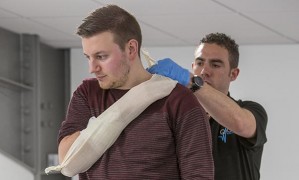This accredited qualification provides theoretical and practical training in First Aid techniques that are specific to infants aged 0 to 1, and children aged from 1 year old to the onset of puberty. Learners will become familiar with the role of the paediatric first aider and be able to assess and react appropriately to an emergency situation, such as a child or an infant who is unresponsive, has an airway obstruction or is suffering from shock.
Topics also included are wounds, fractures, dislocations, injuries to the head, neck, back, eyes, ears or nose, poisoning, bites or stings and electric shock.
The Statutory Framework for the Early Years Foundation Stage is a document published by The Department for Children, Schools and Families and applies to Early Years childcare within England, Wales and Northern Ireland. The Statutory Framework states that ‘at least one person who has a current paediatric first aid certificate must be on the premises at all times when children are present. There must be at least one person on outings who has a current paediatric first aid certificate.’ The TQUK Level 3 Award in Paediatric First Aid (RQF) is recognised as a qualification that fulfils this need.
To comply with current requirements in the childcare sector, you must take this qualification again after three years. This must be taken as the two days again, there is no shorter course if you have taken the course before.
Course Curriculum:
Unit 1:
Emergency Paediatric First Aid
- Understand the role and responsibilities of the paediatric first aider
- (Define responsibilities of a paediatric first aider, Explain how to minimise the risk of infection to self and others, Describe first aid and personal protection equipment required for emergencies, Describe how to use first aid and personal protection equipment safely, Identify what information needs to be included in an accident report/incident record, Explain reporting procedures following an accident/incident, Define an infant and a child for the purposes of first aid treatment)
- Be able to assess an emergency situation safely
- (Conduct a scene survey, Conduct a primary survey on an infant and a child, Identify when to call for help, Explain what information needs to be given when obtaining assistance)
- Be able to provide first aid for an infant and a child who is unresponsive and breathing normally
- (Assess the level of consciousness of an infant and a child, Explain why an infant and a child should be placed in the recovery position, Place an infant and a child in the recovery position, Continually monitor an infant and a child whilst they are in the recovery position, Assist an infant and a child who is experiencing a seizure)
- Be able to provide first aid for an infant and a child who is unresponsive and not breathing normally
- (Identify when to administer Cardio Pulmonary Resuscitation (CPR) to an unresponsive infant and an unresponsive child who is not breathing normally, Administer CPR using an infant and a child manikin)
- Be able to provide first aid for an infant and a child who has a foreign body airway obstruction
- (Identify when a foreign body airway obstruction is mild and severe, Administer first aid to an infant and a child who is choking)
- Be able to provide first aid to an infant and a child with external bleeding
- (Describe the types and severity of bleeding, Explain the effect of severe blood loss on an infant and a child, Control external bleeding)
- Understand how to provide first aid to an infant and a child who is suffering from shock
- (Define the term ‘shock’ relevant to first aid, Describe how to recognise an infant and a child who is suffering from shock, Explain how to manage the effects of shock)
- Understand how to provide first aid to an infant and a child with anaphylaxis
- (List common triggers for anaphylaxis, Describe how to recognise anaphylaxis in an infant and a child, Explain how to administer first aid for an infant and a child with anaphylaxis)
Unit 2:
Managing paediatric illness and injury
- Be able to administer first aid to an infant and a child with injuries to bones, joints and muscles
- (Describe types of fractures, Recognise suspected fractures, dislocations, stains and sprains, Administer first aid for suspected fractures, dislocations, stains and sprains)
- Be able to administer first aid to an infant and a child with head and spinal injuries
- (Describe how to recognise suspected concussion, skull fracture, cerebral compression spinal, Administer first aid for suspected suspected concussion, skull fracture, cerebral compression spinal)
- Understand how to administer first aid to an infant and a child with conditions affecting the eyes, ears and nose
- (Identify conditions affecting the eyes, ears and nose, Explain the action to take when conditions are identified)
- Understand how to administer emergency first aid to an infant and a child with a chronic medical condition or sudden illness
- (Describe how to recognise sickle cell crisis, diabetic emergency, asthma attach, allergic reaction, meningitis and febrile convulsions, Explain how to manage sickle cell crisis, diabetic emergency, asthma attach, allergic reaction, meningitis and febrile convulsions)
- Understand how to administer first aid to an infant and a child who is experiencing the effects of extreme heat or cold
- (Describe how to recognise the effects of extreme heat and extreme cold, Explain how to manage the effects of extreme heat and extreme cold)
- Understand how to administer first aid to an infant and a child who has sustained an electric shock
- (Explain how to safely manage an incident involving electricity, Describe first aid treatments for electric shock incidents)
- Understand how to administer first aid to an infant and a child with burns or scalds
- (Describe how to recognise the severity of burns and scalds, Explain how to manage burns and scalds)
- Understand how to administer first aid to an infant and a child who has been poisoned
- (Identify the routes that poisonous substances take to enter the body, Identify sources of information for treating those affected by sudden poisoning, Explain how to manage sudden poisoning)
- Understand how to administer first aid to an infant and a child who has been bitten or stung
- (Identify severity of bites and stings, Explain how to manage bites and stings)
- Understand how to administer first aid to an infant and a child with minor injuries
- (Explain how to administer first aid for small cuts, grazes, small splinters and bumps and bruises and nose bleeds)
- Understand how to complete records relating to illnesses, injuries and emergencies
- (Identify what information needs to be recorded for illnesses, injuries and emergencies, Describe how to record the information for illnesses, injuries and emergencies, Explain confidentially procedures for recording, storing and sharing information)
Course Duration:
This course has a guidance training time of 12 hours, this is completed over two days.
Certification:
Each student will gain a TQUK Level 3 Award in Paediatric First Aid (RQF) regulated qualification.
For more information or to book a course, please contact us here.
-

Our Clinical Training provides up to date information for clinicians. This will provide continuing professional development (CPD) hours towards revalidation for nurses and midwives.
View courses
-

Our health & safety training courses provide the fundamentals any organisation or individual requires to be compliant with HSE guidelines, ranging from Manual Handling, Health & Safety, Fire Safety and Food Hygiene Training.
View courses
-

Our emergency care training includes Paediatric and Adult based courses. Whether you're a builder, childminder, carer or doctor it is essential you understand the basic skills required for potentially saving a life.
View courses


